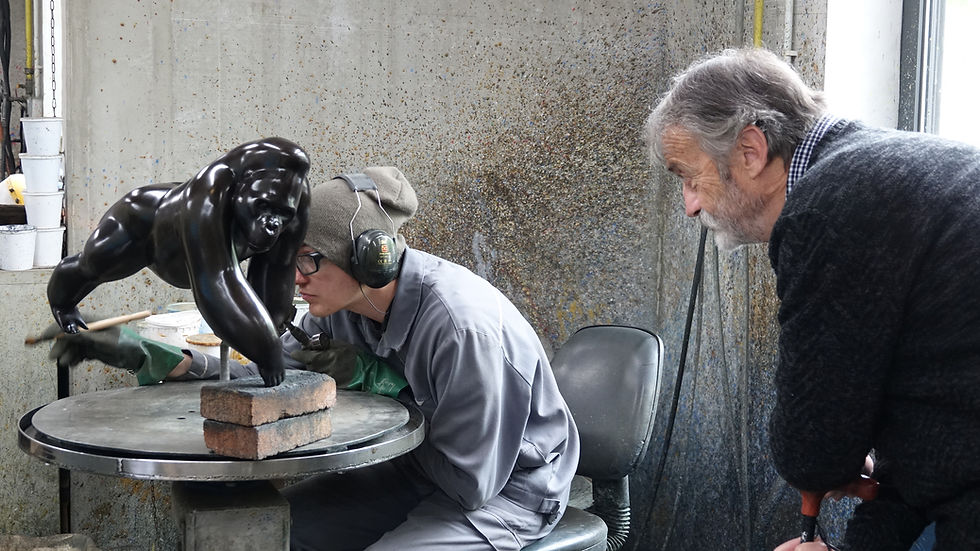Fragile Giants: when Art puts itself at the service of Nature
- sculpturebass
- Jun 29, 2021
- 3 min read

In the heart of the Jardin des Plantes in Paris, facing the magnificent Verniquet amphitheater, a few meters from the wallabies, new residents have found refuge. Under the curious and amazed eye of thousands of visitors, monumental gorillas, brown and white bears pose.
At the invitation of the National Museum of Natural History, Michel BASSOMPIERRE exhibits from May 1 until August 31 five of his favorite animals. His “Fragile Colossi” represent endangered species. Their habitats, forests and ice floes, are indeed undermined by climate change and human pressure.
"These animals are emblematic of ecosystems," explains primatologist Sabrina KRIEF, professor at the National Museum of Natural History and scientific director of the exhibition. "If we want to do everything to protect them, it's because a world without gorillas and bears would be absolutely sad, but also because their ecosystems are vital for thousands of other animal and plant species ".
Discussions about the exhibition

Exhibited on these lawns in a magnificent setting, far from the hustle and bustle of the capital, the colossi serve a cause: to raise awareness of the fragility of the living world. "When I look at Michel's works, it provokes what I have always called this first step, which is an essential step and which is the first step towards respect: wonder" confides Nicolas HULOT. "This is how Art can be at the service of Nature, because if we reconnect with beauty, if all of a sudden we lift our eyes from our screens and look at that beauty, we have taken perhaps the most essential step! ".
During an unprecedented meeting hosted by journalist Wendy BOUCHARD, Nicolas HULOT and Sabrina KRIEF spoke with Michel BASSOMPIERRE about the exhibition, sharing their sensitive outlook on the beauty of nature and the urgency of preserving it.
They talk about it
Boulevard de la Seine

In the program Boulevard de la Seine on May 22, on France 3 Paris, hosted by Wendy BOUCHARD, actor and director Jacques WEBER talks about his discovery of the exhibition and of the monograph: “BASSOMPIERRE, c'est une pure marvel . It’s beautiful, in a move, it’s amazing. They are posed a bit like the Mayols at the Tuileries, and it is overwhelming. It's sensuality and restrained power, it's sublime ".
La Terre au Carré

On the occasion of the launch of the exhibition, the program "La Terre au Carré", from France Inter, invited Michel BASSOMPIERRE and Sabrina KRIEF on May 14. For an hour, they answered questions from Mathieu VIDARD on art, science and the preservation of animal and plant species.
The Museum and Michel BASSOMPIERRE: a story spanning nearly 70 years.
When he discovered the National Museum of Natural History for the first time, Michel BASSOMPIERRE was only 5 years old. As a little Parisian, he went to the Ménagerie du Jardin des Plantes, to observe the animals, but also to meet his researchers.
"I was very young when I first set foot at the Museum of Natural History. My father had a friend, Abbé LAVOCAT, a paleontologist who took care of rodent teeth. We had entered his office. My father, who was a geologist, discussed geology and Africa with him. And then after we went out and saw the great gallery with all its dinosaurs, it was something extraordinary. I never thought that one day I would have animals exhibited in flesh, blood and spirit, on one of the lawns of one of the first iconic places I had discovered. "
Works exhibited at the Jardin des Plantes as part of the "Fragiles Colosses" exhibition

La Banquise n ° 2 - POLAR BEAR,
Status in the Red List of the International Union for Conservation of Nature: vulnerable
Population: There are an estimated 26,000 individuals in 19 subpopulations over 24,000,000 km2 in the arctic regions.
Salmon n ° 1 / Honey n ° 5 - BROWN BEAR,
Status in the Red List of the International Union for Conservation of Nature: Least Concern
Threat status in France: Critically endangered
Population: there are 110,000 individuals spread over 45 countries.
In Europe, 14,000 brown bears that live in highland forests.
The Dominant n ° 5 / The Silver Back n ° 7 - WEST GORILLAS,
Status in the Red List of the International Union for the Conservation of Nature: Critically Endangered
Population: 150,000 to 300,000 Western gorillas live in the rainforests of seven African countries.
This exhibition is organized in partnership with the Galleries BARTOUX.



























Comments